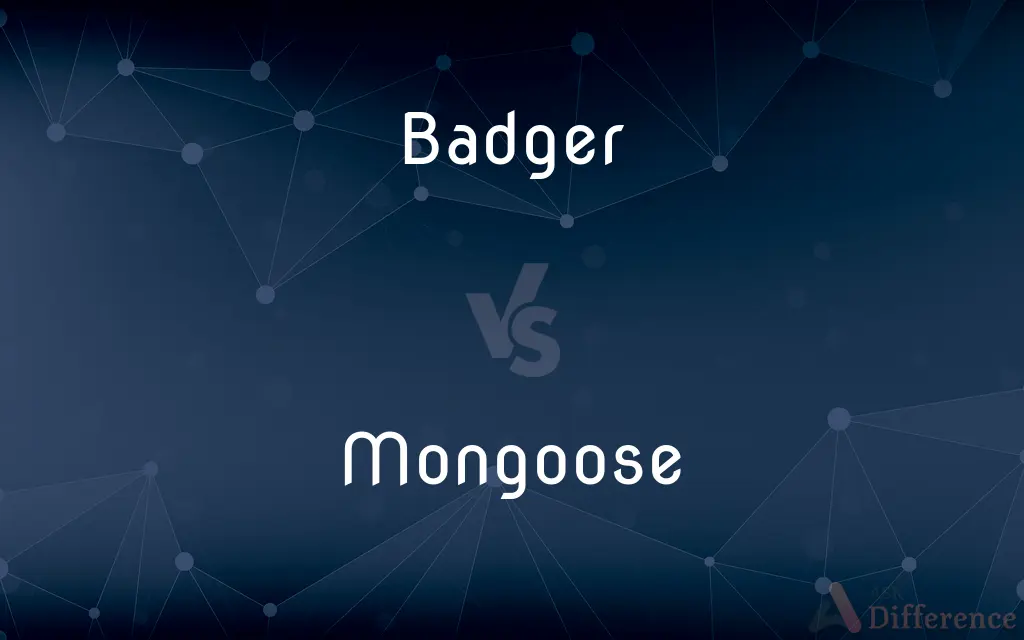Badger vs. Mongoose — What's the Difference?
By Urooj Arif & Fiza Rafique — Updated on March 16, 2024
Badgers are sturdy, burrowing animals primarily found in North America and Europe, known for their digging abilities, while mongooses are agile, carnivorous mammals, famous for their snake-fighting skills.

Difference Between Badger and Mongoose
Table of Contents
ADVERTISEMENT
Key Differences
Badgers are members of the family Mustelidae, which includes otters, weasels, and ferrets. They have a broad body, short legs, and are known for their powerful digging abilities, using their sharp claws to excavate extensive burrow systems called setts. Badgers are omnivores, feeding on a varied diet that includes worms, fruit, and small mammals. On the other hand, mongooses belong to the family Herpestidae and are primarily found in Africa, southern Asia, and southern Europe. They are slender, small to medium-sized carnivores with a reputation for their remarkable ability to kill venomous snakes. Mongooses have a more varied habitat range, from forests to savannahs, and their diet mainly consists of insects, crabs, earthworms, lizards, birds, and rodents.
Badgers have a unique social structure, with some species like the European badger (Meles meles) living in complex social groups, while others are solitary. They are mostly nocturnal and spend a significant amount of time in their burrows. Mongooses, however, exhibit a range of social behaviors from solitary to living in large colonies. Many species of mongoose are diurnal, actively foraging for food during the day. Their social interactions and group living, especially in species like the banded mongoose, contribute to their success in a variety of environments.
The physical appearance of badgers is characterized by their stocky bodies, short tails, and distinctive black and white striped faces, which varies among species. They rely on their strong forelimbs and claws for digging and defense. In contrast, mongooses typically have a leaner build, with elongated bodies, short legs, and tapered tails. Their fur color varies widely from grey to brown, often with speckled or banded patterns, providing camouflage in their natural habitats.
Regarding reproduction, badgers have a unique aspect known as delayed implantation, where the embryo does not immediately implant in the uterus after fertilization, allowing them to give birth at a time of year when conditions are more favorable. Mongooses, on the other hand, do not exhibit this reproductive strategy and tend to have more straightforward breeding cycles, with several species capable of breeding multiple times a year.
Both badgers and mongooses play significant roles in their ecosystems as predators of various pests. However, their interactions with humans vary. Badgers are often considered pests themselves in some regions due to their burrowing activities that can damage crops and landscapes. Conversely, mongooses were introduced to certain areas, like Hawaii and the Caribbean, to control rodent and snake populations, though their presence has sometimes led to negative ecological impacts due to their predation on native species.
ADVERTISEMENT
Comparison Chart
Family
Mustelidae
Herpestidae
Habitat
North America, Europe, Asia
Africa, southern Asia, southern Europe
Diet
Omnivore (worms, fruit, small mammals)
Carnivore (insects, crabs, earthworms, small vertebrates)
Social Structure
Complex social groups or solitary
Solitary to large colonies
Physical Characteristics
Stocky body, short legs, black and white striped face
Lean build, elongated body, short legs, tapered tail
Reproduction
Delayed implantation
Straightforward breeding cycles
Human Interaction
Often considered pests due to burrowing
Introduced in some areas for pest control, sometimes leading to ecological issues
Compare with Definitions
Badger
Lives in complex social groups called setts.
The badger sett was a network of tunnels and chambers.
Mongoose
A small to medium-sized carnivore known for fighting snakes.
The mongoose swiftly attacked the venomous snake.
Badger
Has a distinctive black and white striped face.
The young badger's striped face was barely visible in the den's entrance.
Mongoose
Primarily eats insects, crabs, and small vertebrates.
The mongoose foraged for insects in the underbrush.
Badger
Exhibits delayed implantation in reproduction.
The female badger gave birth in spring, months after mating.
Mongoose
Can live solitarily or in large colonies.
A large colony of mongooses took over the abandoned burrow.
Badger
A sturdy, burrowing mammal known for its digging abilities.
The badger used its sharp claws to excavate a burrow.
Mongoose
Lives in a variety of habitats from forests to savannahs.
The mongoose family was spotted sunbathing on the savannah.
Badger
Omnivorous, feeding on a variety of foods.
The badger was seen foraging for worms and berries at dusk.
Mongoose
Does not exhibit delayed implantation.
The mongoose litter was born just a few weeks after mating.
Badger
Badgers are short-legged omnivores mostly in the family Mustelidae (which also includes the otters, polecats, weasels, and ferrets), but also with two species called "badgers" in the related family Mephitidae (which also includes the skunks). Badgers are a polyphyletic grouping, and are not a natural taxonomic grouping: badgers are united by their squat bodies, adapted for fossorial activity.
Mongoose
A mongoose is a small terrestrial carnivorous mammal belonging to the family Herpestidae. This family is currently split into two subfamilies, the Herpestinae and the Mungotinae.
Badger
Any of several carnivorous burrowing mammals of the family Mustelidae, such as Meles meles of Eurasia or Taxidea taxus of North America, having short legs, long claws on the front feet, and a heavy grizzled coat.
Mongoose
A small carnivorous mammal with a long body and tail and a grizzled or banded coat, native to Africa and Asia.
Badger
The fur or hair of any of these mammals.
Mongoose
Any of various carnivorous mammals of the family Herpestidae, native to Asia, Africa, and southern Europe and introduced elsewhere, having a slender agile body and a long tail, and noted for the ability to seize and kill venomous snakes.
Badger
Any of several similar mammals, such as the ratel.
Mongoose
Any of several species of generalist predatory Carnivores in the family Herpestidae; the various species range in size from rats to large cats. The Indian mongoose is noted as a predator of venomous snakes, though other mongoose species have similar habits.
Badger
To ask or nag (someone) about something in an annoying and persistent way; pester
Badgered the boy into cleaning his room.
Mongoose
Any species of pl=s; only distantly related to the Herpestidae, these are members of the family Eupleridae; they resemble mongooses in appearance and habits, but have larger ears and ringed tails.
Badger
Any mammal of three subfamilies, which belong to the family Mustelidae: Melinae (Eurasian badgers), Mellivorinae (ratel or honey badger), and Taxideinae (American badger).
Mongoose
A species of ichneumon (Herpestes griseus), native of India. Applied also to other allied species, as the African banded mongoose (Crossarchus fasciatus).
Badger
A native or resident of the American state, Wisconsin.
Mongoose
A Madagascan lemur (Lemur mongos).
Badger
(obsolete) A brush made of badger hair.
Mongoose
Agile grizzled Old World viverrine; preys on snakes and rodents
Badger
A crew of desperate villains who robbed near rivers, into which they threw the bodies of those they murdered.
Badger
(obsolete) An itinerant licensed dealer in commodities used for food; a hawker; a huckster; -- formerly applied especially to one who bought grain in one place and sold it in another.
Badger
To pester; to annoy persistently; to press.
He kept badgering her about her bad habits.
Badger
An itinerant licensed dealer in commodities used for food; a hawker; a huckster; - formerly applied especially to one who bought grain in one place and sold it in another.
Badger
A carnivorous quadruped of the genus Meles or of an allied genus. It is a burrowing animal, with short, thick legs, and long claws on the fore feet. One species (Meles meles or Meles vulgaris), called also brock, inhabits the north of Europe and Asia; another species (Taxidea taxus or Taxidea Americana or Taxidea Labradorica) inhabits the northern parts of North America. See Teledu.
Badger
A brush made of badgers' hair, used by artists.
Badger
To tease or annoy, as a badger when baited; to worry or irritate persistently.
Badger
To beat down; to cheapen; to barter; to bargain.
Badger
Sturdy carnivorous burrowing mammal with strong claws widely distributed in the northern hemisphere
Badger
Annoy persistently;
The children teased the boy because of his stammer
Badger
Persuade through constant efforts
Common Curiosities
What do mongooses eat?
Mongooses primarily eat insects, crabs, earthworms, lizards, birds, and rodents.
How do badgers and mongooses differ in their habitats?
Badgers are found in North America, Europe, and Asia, preferring wooded and open areas, whereas mongooses inhabit Africa, southern Asia, and southern Europe, with a wider range of habitats from forests to savannahs.
Why were mongooses introduced to some areas?
Mongooses were introduced to places like Hawaii and the Caribbean to control rodent and snake populations.
What is unique about badger reproduction?
Badgers exhibit delayed implantation, allowing them to give birth when environmental conditions are favorable.
Can badgers be considered pests?
In some regions, badgers are considered pests due to their burrowing activities that damage crops and landscapes.
Are mongooses good at fighting snakes?
Yes, mongooses are renowned for their ability to fight and kill venomous snakes.
What family do badgers belong to?
Badgers are part of the Mustelidae family.
Do badgers live in groups?
Some species of badgers, like the European badger, live in complex social groups, while others are solitary.
What are the physical characteristics of a mongoose?
Mongooses have a lean build, elongated bodies, short legs, and tapered tails, often with speckled or banded patterns.
How do mongooses interact with their environment?
Mongooses adapt to a variety of environments, from solitary to living in large colonies, and play a role in controlling pest populations.
Do badgers have a specific diet?
Badgers are omnivores, eating a varied diet including worms, fruit, and small mammals.
What type of social structure do mongooses have?
Mongooses can live solitarily or in large colonies, depending on the species.
How do badgers defend themselves?
Badgers use their sharp claws and powerful bodies for digging and defense.
What ecological impacts have mongooses had in introduced areas?
In some introduced areas, mongooses have negatively impacted native species through predation.
Are all mongooses diurnal?
Many mongoose species are diurnal, but activity patterns can vary among species.
Share Your Discovery

Previous Comparison
Lowly vs. Humble
Next Comparison
Abacus vs. CalculatorAuthor Spotlight
Written by
Urooj ArifUrooj is a skilled content writer at Ask Difference, known for her exceptional ability to simplify complex topics into engaging and informative content. With a passion for research and a flair for clear, concise writing, she consistently delivers articles that resonate with our diverse audience.
Co-written by
Fiza RafiqueFiza Rafique is a skilled content writer at AskDifference.com, where she meticulously refines and enhances written pieces. Drawing from her vast editorial expertise, Fiza ensures clarity, accuracy, and precision in every article. Passionate about language, she continually seeks to elevate the quality of content for readers worldwide.















































